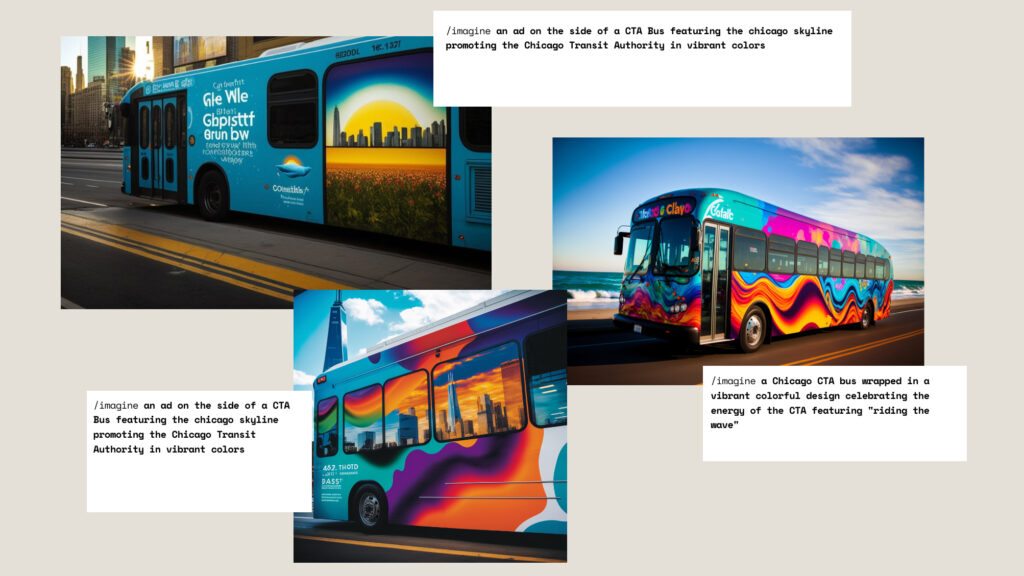This Agency’s ChatGPT Experiment Prompted Recruiters to Request Interviews With an AI
Join iconic brands and world-class marketing leaders at Brandweek to unlock powerful insights and impact-driven strategies. Attend in Miami or virtually, Sept. 11–14. Save 50% with early-bird passes.
Recruiters are calling Austin Anglin, an art director at the independent Atlanta agency 22Squared. They aren’t interested in interviewing him. Instead, they want to reach an art director named Alex Irving.
The caveat? Irving isn’t human. They’re the pseudonym behind the AI-produced creative portfolio Anglin created with his co-worker, 22Squared senior copywriter Emma Murf.
Using ChatGPT and Midjourney AI tools, the creatives dreamed up Irving (who they’ve deemed the first AI art director), built a portfolio for the digital entity and applied to real job listings using AI-generated work. The experiment helped answer a question that troubled them: Can AI replace take their jobs?
Can AI replace creatives?
Anglin, who works across agency accounts like Toyota, had been using online AI tools like ChatGPT and Midjourney to determine how 22Squared could use them advantageously. As Murf conducted her own research in tandem, eventually, the co-workers learned of their mutual interest in the technology.
They traded notes, noticing a surplus of ominous online content insinuating that AI might soon, or could eventually, replace creatives.

“We really kept finding a lot of articles about how it’ll replace everything…There were quite a few about creatives, especially copywriters, as well as art directors. You know—the jobs we do every day,” Anglin told Adweek.
Creating Alex Irving
That’s when Murf and Anglin decided to conduct an experiment, and asked ChatGPT’s AI tool to develop a creative profile for a fictionalized art director.
“We basically aggregated the power of several AI software to create what we have deemed the world’s first AI art director. Their name is Alex Irving–AI,” Murf said. The duo asked the AI to create a portfolio featuring six different projects, which it completed, guided by Murf and Anglin’s promptings, in just three days’ time.
To gauge if the AI-generated portfolio was impressive enough to score Irving interviews for real jobs, the creatives used it to apply to open postings.
“We think of it almost like a CAPTCHA test for the advertising industry. Like, can you spot that fingerprint of artificial creativity?” Murf said. Some recruiters couldn’t, with Irving’s portfolio garnering their interest.

To design visually attractive campaigns, the creatives fed the AI prompts and asked it to craft creative concepts for a particular brand. In one case, they asked ChatGPT to develop a campaign for the Chicago Transit Authority, for which it produced creative executions and named the campaign “Riding The Wave Of Chicago.” Despite the two pitching Irving to recruiters as an art director, they relied entirely on AI to produce all the copy within the fictionalized portfolio. They even asked ChatGPT to decide what the campaign’s creative executions should look like.
The software suggested custom bus wraps complete with CTAs. Later, the duo shared the concept with Midjourney, an AI imaging tool, which produced the creative.
The AI tools developed Irving’s portfolio over the course of just three days, confirming the creatives’ hypothesis that an AI tool could create a finished product much more efficiently than a human art director. “There’s absolutely time saved by using these tools. There’s no doubt about it,” said Anglin.
It ‘couldn’t get into deeper concepts’
There were two significant problems.
First, the AI-generated images failed to generate clear text.
“They’re all very intentionally prevented from doing that,” said Anglin. “‘Ride The Wave Of Chicago’ was more of like a blob that had letter forms. It was that font, it just wasn’t all white words that you could read,” he added.
The creatives helped the AI create the campaign’s text components, which they did using Adobe Photoshop’s font finder tool.
Second, Murf and Anglin found the AI couldn’t develop deeper creative concepts. “The Chicago Transit Authority, the Audible campaigns, are really visually stunning and really well written, but the concepts are very ‘first thought,’” the art director said.
The tool itself explained why. After it completed the project, Murf interviewed the ChatGPT AI about its experience crafting the portfolio.
“I cannot have spontaneous breakthroughs, be surprised by my own creations, or have the subjective experience of feeling creative,” the AI told her.
How AI can enhance creative work
The duo doesn’t plan to take the hiring experiment further. After finding that the AI tools couldn’t develop original ideas, and the extent to which they required human prompting, Murf and Anglin felt more at ease.
The process also revealed how AI tools can aide junior creatives in becoming more strategic. The two felt momentarily able to assume the role of creative director, as they developed the software’s ideas and provided it guidance. In addition to a time-saving idea generator, they found, it also presents opportunities for creatives to pressure test their strategic vision and develop professionally.
“As is often the case with with social experiments, the question that you start with doesn’t end up being the real question in the end,” said Murf. “The question started to become, not how will AI replace us, but how can it enhance us.”
https://www.adweek.com/agencies/this-agencys-chatgpt-experiment-prompted-recruiters-to-request-interviews-with-an-ai/
